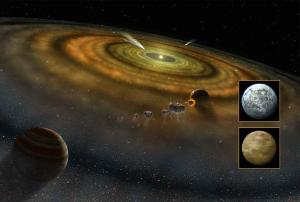Blog
Exocomet
11 January 2014
 Lynette Cook/NASA
Lynette Cook/NASAI’ve talked quite a bit about planets around other stars, known as exoplanets. Most of the exoplanets we’ve discovered are Neptune-sized worlds, but we’ve found exoplanets smaller than Mercury. But in terms of size, that is about our limit given current technology.
Given what we understand about our own solar system, we would expect that these exoplanetary systems also have smaller objects, including asteroids and comets. We haven’t observed any exo-asteroids, but we have detected exocomets. This is pretty remarkable, since most of the exoplanets we’ve discovered are through things like transit data and the like. We have only imaged a few of the larger exoplanets, and then only as a small blur.
So how can we detect comets around other stars? Even though comets are much smaller than planets, they vent dust and gas when they are active, which produces the coma and tail of a comet. It is the vented gas that we can detect.
For example, an upcoming article in Astronomy and Astrophysics looked at data from the High Accuracy Radial Velocity Planet Searcher (HARPS).1 The main goal of HARPS is to measure the Doppler motion of stars, and to do that it needs to make good observations of the line spectra from stars. These line spectra can be used to “fingerprint” the various elements and molecules that exist in the star.
In this case the data was from a star known as HD 172555, which is a young star where a planetary system is still forming. This means it still has a disk of gas and dust around it. The HARPS telescope looked at line spectra from this circumstellar disk, and the team found that a few of the spectral lines were transient. Sometimes being visible in the spectrum of the star, but not seen at other times. When the team measured the Doppler shift of these transient lines, they didn’t match the overall Doppler shift of the star. This means the lines were not due to some change in the star itself.
The most likely explanation is that these transient lines occur when gaseous material passes in front of the star, thus absorbing some of the starlight at particular wavelengths. This is exactly the type of thing you would expect if a comet passes in front of its star. Thus we have observational evidence of comets around other stars.
One of the interesting things about the exocomets detected so far is that they are all part of young solar systems. We typically think of comets as icy remnants from the formation of our solar system, the leftover bits that never became part of planets. That’s true for the comets of our system, because ours is an older solar system. But as a planetary system forms, clumps of dust and ice form into comets and protoplanetary asteroids, many of which collide to form planets over time.
These exocomets are not remnants of an old solar system, but rather the seeds of new ones.
Kiefer, Flavien, et al. “Exocomets in the circumstellar gas disk of HD 172555.” Astronomy & Astrophysics 561 (2014): L10. ↩︎